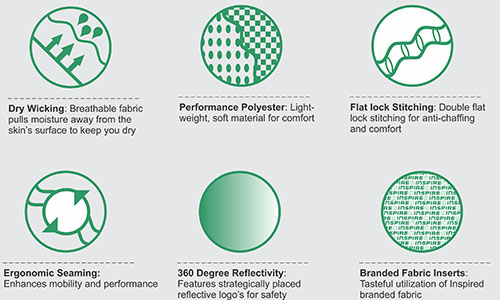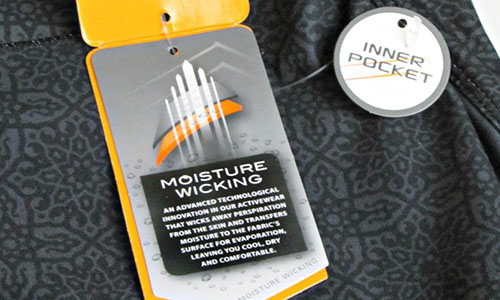Everything You Need to Know About Moisture-Wicking Clothing
Author

Chris shares his passion for cycling, hiking, skiing, and climbing from Buxton, in the Peak District. As a blogger for Outdoor Look, Chris shares outdoor tips and indoor tricks to help you get the most out of your time spent outside. When he's not out adventuring he's making videos or trying to keep up with his 4-year-old son.
 You must have heard of a word “moisture-wicking”. A lot of brands manufacture clothing using moisture-wicking fabric. But what does it actually mean?
You must have heard of a word “moisture-wicking”. A lot of brands manufacture clothing using moisture-wicking fabric. But what does it actually mean?
A moisture-wicking fabric helps transfer the sweat to the outer layer of the fabric quickly and enhances the evaporation process that wicks the moisture away from the clothes. This helps keep you dry and comfortable.
Working of Moisture-Wicking Fabric
A moisture-wicking fabric works on the process of capillary action. Through the molecular spaces in the fabric, the sweat is moved out to the external layer of the fabric. The fabric goes under a variety of tests and treatment to measure its moisture-wicking ability.
You need not study the about the fabric construction, but only look for the word “moisture-wicking” while purchasing the clothing for outdoor activities.
Types of Moisture-Wicking Fabrics
Synthetics: High Moisture-Wicking Performance
A fabric can have a poor moisture-wicking performance and good moisture-wicking performance. The fabric with poor performance traps the liquid in the yarns and does not transfer out from the fabric. On the other hand, a fabric with good moisture-wicking performance, resists the penetration of liquid in the yarns. These are synthetic fabrics which are also known as hydrophobic fabric. The most commonly known synthetic fabrics include nylon, polyester, spandex, Nike Dri-fit, and polypropylene
Wool: Low Moisture-Wicking Performance
 The wool has tiny openings in it that absorb a little amount of moisture. Through these openings, it wicks the moisture away, keeping the wool yarns dry.
The wool has tiny openings in it that absorb a little amount of moisture. Through these openings, it wicks the moisture away, keeping the wool yarns dry.
Cotton: No Moisture-Wicking Ability
The cotton is a non-moisture-wicking fabric as it absorbs the liquid, becomes heavy and takes a time to dry. At first, you’ll feel greasy and hot and after some time when the fabric starts to dry, it leaves your skin cool. There are many cotton fabrics that are manufactured with moisture-wicking technology, but still they cannot meet the standard of the synthetics and wool. The garments manufactured with cotton having moisture-wicking performance are ideal for low-impact activities such as yoga, walking, and riding a bicycle.
Reason to Shop for Moisture-Wicking Clothing
During perspiration, the evaporation process of sweat gives you a cooling sensation. Your body stops sweating once the skin reaches the normal temperature. For those, who indulge in sports activities or heavy workout, having a moisture-wicking clothing is a must. It gives you a soft feel while keeping you dry throughout the activity.
Washing Instructions for Moisture-Wicking Clothing
It is necessary to follow the washing instructions for moisture-wicking clothing. Washing them using a liquid or a dry sheet fabric softener is not recommended. The performance of the fabric is reduced as the fabric softener leaves a greasy residue on it.
You need to turn the garment inside out and wash it in the cold water without using any fabric softener or detergent. Use only water. Allow it to dry naturally. It is suggested not to use a dryer to dry it out as the high intensity of heat can affect the moisture-wicking performance of the fabric.
Author

Chris shares his passion for cycling, hiking, skiing, and climbing from Buxton, in the Peak District. As a blogger for Outdoor Look, Chris shares outdoor tips and indoor tricks to help you get the most out of your time spent outside. When he's not out adventuring he's making videos or trying to keep up with his 4-year-old son.
- Speed Up Your Post-Hike Recovery with These 6 Essential Tips
- Cycling through Tranquil Roads and Coastal Views on the Isle of Wight
- The Essential Guide to Hiking Safety: 5 Tips Every Hiker Should Know
- Run Smart, Run Strong: Your Guide to Injury-Free Running
- Embrace Biking: Essential Tips for Beginners
Categories
- Sport (28)
- Product Reviews (3)
- Team Outdoor Look (7)
- Mike Wild (2)
- Mike Payton (2)
- Suse Hammond-Pears (3)
- Snowboarding (12)
- Latest Offers (105)
- Shop Talk (1)
- Competitions (7)
- Walking (413)
- Lifestyle Fashion (8)
- Travel (86)
- Kit Guides (176)
- Workwear Clothing (6)
- Safety Workwear (4)
- Health/Fitness (289)
- Skiing (91)
- Great Outdoors (1316)
- Cycling (92)
- January 2025
- December 2024
- November 2024
- October 2024
- September 2024
- August 2024
- July 2024
- June 2024
- May 2024
- April 2024
- March 2024
- February 2024
- January 2024
- December 2023
- November 2023
- October 2023
- September 2023
- August 2023
- July 2023
- June 2023
- May 2023
- April 2023
- March 2023
- February 2023
- January 2023
- December 2022
- November 2022
- October 2022
- September 2022
- August 2022
- July 2022
- June 2022
- May 2022
- April 2022
- March 2022
- February 2022
- January 2022
- December 2021
- November 2021
- October 2021
- September 2021
- August 2021
- July 2021
- June 2021
- May 2021
- April 2021
- March 2021
- February 2021
- January 2021
- December 2020
- November 2020
- October 2020
- September 2020
- August 2020
- July 2020
- June 2020
- May 2020
- April 2020
- March 2020
- February 2020
- January 2020
- December 2019
- November 2019
- October 2019
- September 2019
- August 2019
- July 2019
- June 2019
- May 2019
- April 2019
- March 2019
- February 2019
- January 2019
- December 2018
- November 2018
- October 2018
- September 2018
- August 2018
- July 2018
- June 2018
- May 2018
- April 2018
- March 2018
- February 2018
- January 2018
- December 2017
- November 2017
- October 2017
- September 2017
- August 2017
- July 2017
- June 2017
- May 2017
- April 2017
- March 2017
- February 2017
- January 2017
- December 2016
- November 2016
- October 2016
- September 2016
- August 2016
- July 2016
- June 2016
- May 2016
- April 2016
- March 2016
- February 2016
- January 2016
- December 2015
- November 2015
- October 2015
- September 2015
- August 2015
- July 2015
- June 2015
- May 2015
- April 2015
- March 2015
- February 2015
- January 2015
- December 2014
- November 2014
- October 2014
- September 2014
- August 2014
- July 2014
- June 2014
- May 2014
- April 2014
- March 2014
- February 2014
- January 2014
- December 2013
- November 2013
- October 2013
- September 2013
- August 2013
- July 2013
- June 2013
- May 2013
- April 2013
- March 2013
- February 2013
- January 2013
- December 2012
- November 2012
- October 2012
- September 2012
- August 2012
- July 2012
- June 2012
- May 2012
- April 2012
- March 2012
- February 2012
- January 2012
- December 2011
- November 2011
- October 2011
- September 2011
- August 2011
- May 2010
- April 2010
- March 2010
- February 2010
- January 2010
- November 2009
- October 2009
- September 2009
Submit a Comment